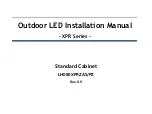
7
Camera Installation
•
DO NOT
attempt to disassemble camera housings. They are sealed to limit water and dust intrusion.
Warranty & IP69k Rating become void if camera is opened.
•
PRIOR
to placing the cameras on the vehicle, the calibration mats should be placed at the front and rear
bumpers of the vehicle. Each camera should be mounted in the highest practical location possible on each of
the 4 sides of the vehicle.
•
Front and rear cameras should be placed as close to center line of vehicle as possible.
An offset of up to 6” is
acceptable, but not recommended.
•
All cameras must be angled so that the vehicle is barely visible. If there is too much of the vehicle body in
image, the system cannot be calibrated.
•
Side cameras should be mounted as close to the horizontal center of vehicle as possible, &
MUST
be
mounted symmetrically to one another. Side cameras should be placed as high as possible.
•
If the cameras must be moved off-center due to an obstruction,
an offset of up to 10% of the vehicle’s
overall length is acceptable; & it is preferred to move the cameras toward the
FRONT
of the vehicle.
•
After installation and wiring, use the provided button harness (STSH360) to check the images from the SIDE
cameras. The image should cover at least 3 feet beyond front and rear bumper.
•
When viewing images from cameras, the bottom of the image should contain approximately 10% of the
vehicle body and/or bumper.
Make sure that the white background of
the pattern is visible between vehicle body
and the closest edge of the triangles.
Summary of Contents for Vision SAFE-T-SCOPE 360
Page 17: ...17 Figure 2 Rear Camera View Figure 3 Right Camera View ...
Page 18: ...18 Figure 4 Left Camera View ...
Page 25: ...25 Application Notes System Overview ...
Page 26: ...26 Generic Installation with Monitor ...
Page 27: ...27 Generic Installation with Monitor and DVR ...
Page 28: ...28 ...








































